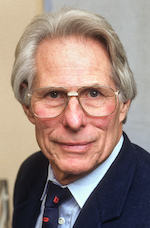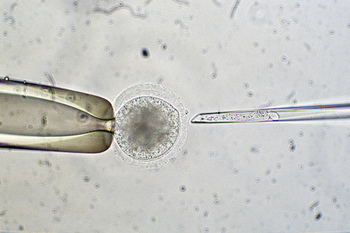Neal First, whose work led to cattle cloning, dies at 84

Neal First, an emeritus professor of animal sciences, is pictured in his research lab in 1997. His work set the stage for in vitro fertilization of cattle and cloning of cattle embryos. First died Nov. 20 from complications of cancer.
Emeritus Professor Neal First, a pioneer in cattle reproduction and cloning who studied animal physiology at the University of Wisconsin–Madison for 45 years, died Nov. 20 from complications of cancer.

Neal First
After getting his Ph.D. at Michigan State University, First started work in 1960 at the UW–Madison Department of Animal Sciences in the College of Agricultural and Life Sciences, where he taught a wide range of courses related to animal health. His lab was best known for studies on the mechanisms of reproduction in swine, cattle and horses.
His work in the 1980s on how sperm and eggs are prepared, or matured, for fertilization set the stage for in vitro (in the lab) fertilization of cattle — something that had already been achieved in humans. Among cattle, IVF now produces as many as a half-million live births each year.
These advances also set the stage for cloning of cattle embryos, says James Robl, who was a postdoc with First during the mid-1980s. “He had a large program, was putting together all the components necessary to do any kind of in vitro manipulation with large-animal embryos, developing methods of in vitro fertilization and embryo cultivation.”
Although these advances later led to cloning from adult cells and to gene transfers, Robl says, “the most important thing that came out of this work was the concept of dedifferentiation — being able to take a more advanced cell nucleus and reprogram it so it could start developing all over again” from a more embryonic state.

DNA is extracted (pipette at right) from an animal egg during a cloning procedure in Professor Neal First’s lab in 1998.
“Back in the early ’80s, most people thought the program of a cell was fixed, and there was not much you could do about it,” Robl explains. “Now that concept has completely changed. You can take just about any adult cell and reprogram it.”
First’s work led to the first cloned calf, playfully named Gene, which was born in 1997 at ABS Global Inc. in DeForest, Wisconsin. At the time, cloning of cattle was so revolutionary that the Wisconsin State Journal quoted this backhanded compliment from an expert: “I have no reason to think it has not happened.”
First is remembered as an agreeable hard driver. “He was a great guy to work with — easygoing, very supportive, but somebody who could get things done,” says Robl. “He didn’t look at a problem and say, ‘I can’t do that in my lab.’ He would say, ‘We need to do this, this and that to get it done.’ I thoroughly enjoyed my time in the lab.”
“He was a really good research mentor,” says John Parrish, a professor of animal sciences at UW–Madison who was also a postdoc with First between 1983 and 1986. “He shared a lot. He taught us how to write grants. And when we had to review a manuscript or a grant, we worked together.”
“He was … somebody who could get things done. He didn’t look at a problem and say, ‘I can’t do that in my lab.’ He would say, ‘We need to do this, this and that to get it done.’”
James Robl
“He generously helped young investigators who were just starting out in their careers,” says James Thomson, director of regenerative biology at the Morgridge Institute for Research at UW–Madison, who was the first to culture embryonic stem (ES) cells in both primates and humans. “When I arrived at UW in the early 1990s as a postdoc, Neal was very supportive of my efforts to derive primate embryonic stem cells. Indeed, he was the National Academy member who communicated my first primate embryonic stem cell paper to PNAS (Proceedings of the National Academy of Sciences). Without that work, and without the support of Neal and the director of the primate center, the human ES cell work would not have been accomplished here.”
Among the many significant awards First received were membership in the National Academy of Sciences in 1989, and the Wolf Prize in Agriculture — one of several prizes awarded by the Wolf Foundation to outstanding scientists and artists — in 1997.




